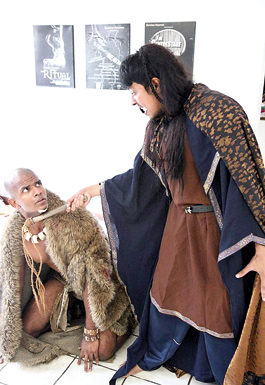Creating a real tempest with Caliban’s Rebellion
View(s):“If thou more murmur’st, I will rend an oak and peg thee in his knotty entrails till thou hast howl’d away twelve winters.”-Prospero to Ariel, The Tempest by Shakespeare; Act 1, Scene 2
Imagine a reversal of roles whilst reading this, if you will. Prospero, the previously benevolent master, is now the vengeful sorcerer and Ariel- that magical spirit of a sidekick- is also a woman, no longer just a man in a man’s world. Alarmed? We thought so. So is director Jehan Aloysius who will stage Caliban’s Rebellion, a reimagining of Shakespeare’s The Tempest, in another two weeks.
If Rag was all about gritty, minimalistic theatre then Caliban’s Rebellion is its antithesis. Where the previous relied on plenty of dialogue and rusty scaffolding as backdrop, Caliban is set to be the ultimate in physical theatre and wild, exotic backgrounds. The 2008 hit is being brought back to stage by Jehan and his fellow CentreStage Productions compatriots and is set to be a cut apart from the previous.

Jehan: Making it relevant
A spin-off from the original Tempest, this is the story of demonised slave Caliban who rebels against malevolent wizard Prospero in an effort to reclaim his island from his European master. “There’s a very strong theme of slavery and colonialism here,” says Jehan. “For me, that makes it very relevant for Sri Lanka – and most countries in the world.” Literature buffs would be interested to know that while Caliban is a spin-off, the entirety of the dialogue in the play comes from the bard’s original itself. “We haven’t altered or added a single line,” says Jehan. Then how is it a sub-plot? It’s all in the interpretation. “This is very physical storytelling. We’ve got fantastical dance sequences, puppets, elaborate miming, made up languages, and a little bit of slapstick and exquisite backdrops…we’re looking at the very limited text we have in terms of body language and visuals.”
Tackling the work of Shakespeare-that universal playwright-is a Herculean task by anyone’s call. Jehan explains that it was easier to work around the dialogue-and whenever they needed some more, they’d just make up a language! “That’s the true power of physical theatre.” Dialogue is a mere vehicle in comparison to the strong theatrics, dance, and music on stage. It’s not done as often in Sri Lanka as he’d like though. He likes to think that these Shakespeare-based productions (Jehan is also the man behind Pyramus and Thisby, a spin off from a Midsummer Night’s Dream) are ‘collaborations’ with the playwright in that he’s merely interpreting the bard’s original text.
That doesn’t mean you’ll get what you expect on stage though. As a director, Jehan believes strongly in artistic licence. This is why Ariel is a black woman (“to emphasize the double bondage of black slavery”) and Prospero, the generically benevolent wizard in the original, is the play’s villain. Once again, it’s all in the interpretation, we’re told. “Dialogue is just dialogue. It’s the delivery that counts.”

Very physical theatre: A scene from Caliban’s Rebellion. Pic by Shehal Joseph
In fleshing out the sub-plot from the original text Jehan found himself looking at a series of strong social themes plaguing the society today. Take Caliban himself, for example. “Here is a man who has been demonised due to his ethnicity and language. The subservience asked of him creates a lot of potential for rebellion.” Ariel, the medium between the enslaved and the master becomes the quintessential kalusuddha, he smiles. “And we can all relate to that, noh?”
The gender-benders in Caliban bring in some extra spice to an already intriguing plot. “Ariel, no matter how powerful and crafty she is, cannot escape the fact that she’s a woman. Prospero is not only the colonial master he’s also a man who happens to be her master.” The plot also tries to answer questions arising from the original, such as how Prospero came into power and the true character of Caliban’s mother. “You may find that people were misrepresented and new relationships are being built,” says the director. “Sometimes, we just need to see things in a different light.”
So why is he doing a remake? The 2008 version received rave reviews from critics and audiences alike. For one, Jehan believes that they made a miscalculation with the venue for the play back then.
“We used a very small -fantastic, but small-theatre and that probably wasn’t conducive to the nature of the play.” For Caliban’s exuberant theatrics only a large space would do and that’s why they’re using the Lionel Wendt this time around. And to be honest, he was a little inspired by the 2010 cinematic reimagining of The Tempest by Julie Taymor. “It’s almost as if she was sitting in the audience when we did it the first time around,” he laughs. “The similarities were uncanny!”
As always, his cast is a heady mix of bright young stars interspersed with the new. CentreStage newcomer Aaron Chitranjan will play Caliban, while old hand Laknath Senevirathne will take on Prospero.
Taking on the other lead roles are Rebecca Munasinghe, Niren Ranasinghe, Anabella Brochard, Eshan Fernando, Natasha Amarasekara and Jehan himself.
Caliban’s Rebellion presented by CentreStage Productions goes on the boards from August 23 -25 at the Lionel Wendt. Tickets and box plan for the show are now available at the Wendt.
Follow @timesonlinelk
comments powered by Disqus


